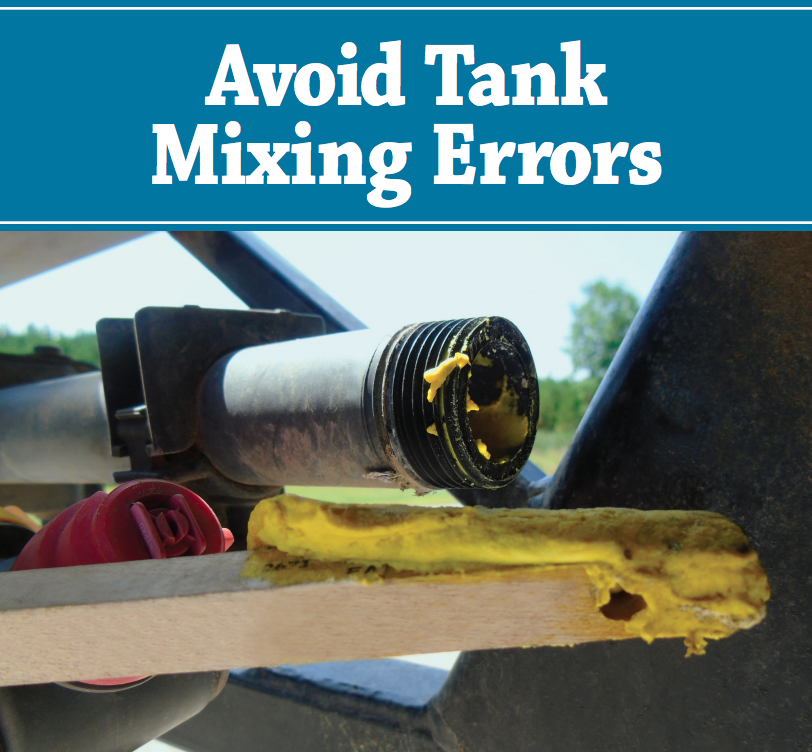
Features
Herbicides
Seed & Chemical
How to avoid tank mix errors
Jason Deveau and Mike Cowbrough share their top tips for growers on how to avoid tank mix errors.
July 4, 2019 By Stephanie Gordon
 Purdue University published a free online resource to Avoid Tank Mixing Errors.
Purdue University published a free online resource to Avoid Tank Mixing Errors. Tank mixing saves time, allows producers to use of multiple modes of action to prevent herbicide resistance, and sometimes boosts the effectiveness of products used. However, errors when the wrong products are tank mixed can result in a costly sprayer clean-up.
Jason Deveau, with Ontario’s Ministry of Agriculture, Food and Rural Affairs, and Mike Cowbrough, with the University of Guelph’s plant agriculture department, presented on how to avoid tank mix errors at Southwest Crop Diagnostic Days held at The University of Guelph Ridgetown Campus over July 3 and 4. They discussed best practices, demonstrated common mistakes and provided tips on how to avoid them.
A wet start to the growing season in Ontario has resulted in more producers tank mixing to catch up from the delayed season. The delayed season could have some producers straying from their original plans and experimenting with new mixes that were not mapped out over the winter.
Some herbicides, fertilizers, or other products, can antagonize each other or reduce each other’s effectiveness when mixed together. Deveau and Cowbrough have no shortage of anecdotal evidence from growers mixing products together and ending up with a new concoction as thick as toothpaste – or worse, a solution mix turned completely solid – that clogs up the sprayer and delays the spraying season. If producers want to add products together, Deveau and Cowbrough break down several tips on how to have a successful tank mix.
The first tip for producers is to make use of available resources. The product label is one of the most definitive resources for growers. “That’s where you are going to find the clear, black and white, do’s and do not’s, but unfortunately some product labels are pretty long, hundreds of pages in some instances,” Cowbrough says.
Instead, Cowbrough recommends the PMRA Label Search. The Pest Management Regulatory Agency (PMRA) Label search is Health Canada’s label database where producers can pull up PDF documents or conduct searches directly instead of flipping through product label pages.
When using the PMRA Label Search, Cowbrough says producers can search for six keywords that will help them avoid tank mix errors:
- Do not mix
- Mix
- Hours
- Agitation
- Fertilizer
- Trade Name
The full phrase “do not mix” is one of the most effective keywords and will provide growers with what products are incompatible with each other. However, searching for “mix” is another essential keyword when finding out which products go together. Keywords such as “hours” and “agitation” are more obscure, but when a label is specifying to do a process within hours, or with agitation, it is a critical detail that makes a difference for a tank mix. Fertilizer is another keyword because mixing a herbicide with a fertilizer is one of the most common mixes. When in doubt, Cowbrough suggests searching for the trade name of the product(s) for results that are specific to what a producer is trying to tank mix.
If a label search is unable to provide answers, Deveau says the next step is to talk to a local sales representative. Chances are the local sales rep has received questions from other growers, or seen previous permutations with the product, and can help answer the question.
When in doubt, conduct a jar test. “Jar testing enables you to do a [tank mix] test in a small mason jar, instead of a $600,000 sprayer,” Deveau says.
The jar test works both ways. Deveau says that if a grower has a mix in the sprayer that resulted in a bad reaction, the first response might be to quickly clean it out but this could create an even bigger mess. If there is a mix in the sprayer that is not working, take a jar and scoop out a sample. With the jar sample, a grower can test out different methods on how to clean or break down the solution. Conducting this backwards version of a jar test prevents a grower from cleaning out the sprayer with detergent, bleach, or other materials that could make the defective mix worse.
Finally, both Deveau and Cowbrough emphasize their key takeaways. Growers should be aware of their order of operations, which products they’re adding first, and to remember to use enough carrier water. Deveau adds that growers should wait a little longer between additions to make sure the products suspend like they’re supposed to.
For more information, Purdue University published a free online resource to Avoid Tank Mixing Errors. The guide is available as a free downloadable PDF document off the Purdue Extension website. The University also created a quick video on how to conduct a jar test as a companion resource to the publication.
Don’t get stuck shovelling out the sprayer – @Spray_Guy and @cowbrough share tips for a successful tank mix at #SWCDD19 #Spray19 pic.twitter.com/1K10lTYxVS
— Top Crop Manager (@TopCropMag) July 4, 2019